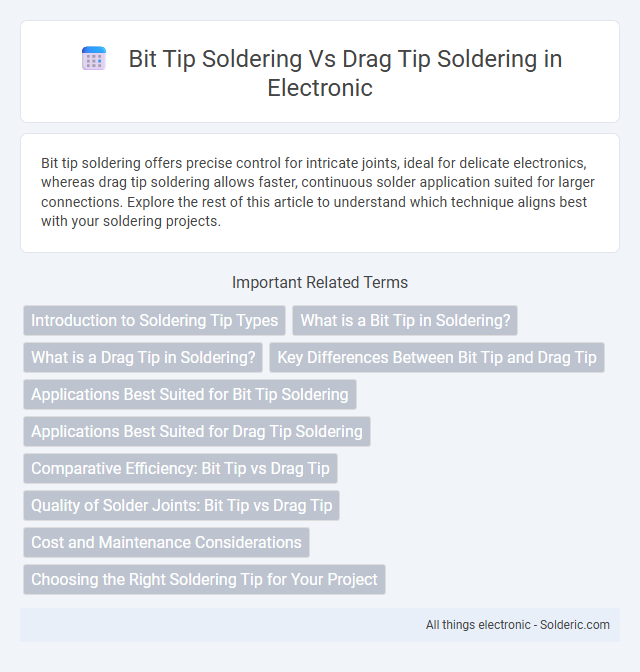Bit tip soldering offers precise control for intricate joints, ideal for delicate electronics, whereas drag tip soldering allows faster, continuous solder application suited for larger connections. Explore the rest of this article to understand which technique aligns best with your soldering projects.
Comparison Table
| Feature | Bit Tip Soldering | Drag Tip Soldering |
|---|---|---|
| Tip Shape | Interchangeable soldering bit | Chisel or knife-shaped tip designed for dragging |
| Technique | Precise point contact for detailed soldering | Drag tip "wipes" solder along joints efficiently |
| Applications | Small components, fine pitch soldering | Surface-mount devices, evenly soldering multiple pins |
| Soldering Speed | Slower, more controlled | Faster, continuous solder application |
| Solder Joint Quality | High precision, reduced bridging risk | Good for mass joints but may increase bridging risk |
| Damage Risk | Lower risk of overheating nearby components | Higher risk if not controlled properly |
| Common Users | Electronics hobbyists, precision repair technicians | Production line assemblers, SMT repair technicians |
| Tool Compatibility | Fits standard soldering irons with bit tips | Requires compatible drag tip soldering irons |
Introduction to Soldering Tip Types
Bit tip soldering features a pointed, conical tip designed for precision work on small components, making it ideal for detailed tasks such as microelectronics. Drag tip soldering employs a flattened or chisel-shaped tip that allows efficient solder transfer over multiple pads, enhancing speed and consistency in soldering larger or closely spaced joints. Choosing between these soldering tip types depends on the specific application, component size, and required precision level.
What is a Bit Tip in Soldering?
A bit tip in soldering refers to a specialized soldering iron tip shaped like a small blade or chisel, designed for precise heat application and enhanced control during soldering tasks. This tip type offers versatility for both surface-mount and through-hole components, allowing you to apply solder efficiently to targeted areas without excessive heat spread. Compared to drag tip soldering, which involves moving the tip across joints to apply solder continuously, bit tip soldering provides more accuracy for detailed electronic work.
What is a Drag Tip in Soldering?
A drag tip in soldering is a specialized soldering iron tip designed for drag soldering techniques, allowing you to efficiently solder multiple closely spaced pins simultaneously. This type of tip typically has a wide, flat shape that facilitates dragging solder across a row of pins, reducing solder bridges and improving connection quality. Unlike bit tips that focus on individual joints, drag tips optimize speed and precision for surface-mount devices with fine pitch components.
Key Differences Between Bit Tip and Drag Tip
Key differences between bit tip soldering and drag tip soldering lie in their design and application techniques. Bit tip soldering uses a chisel or pointed tip to precisely transfer heat and solder to specific points, ideal for delicate and detailed work. Drag tip soldering features a rounded or beveled tip designed to move smoothly across multiple joints, making it efficient for soldering long rows of components or surface-mount devices.
Applications Best Suited for Bit Tip Soldering
Bit tip soldering excels in precision tasks such as microelectronics assembly, where detailed work on small components requires controlled heat application. It is ideal for point soldering, delicate wire connections, and repairing fine-pitch circuit boards due to its ability to deliver focused heat without damaging adjacent parts. This technique outperforms drag tip soldering in scenarios demanding accuracy over continuous solder flow.
Applications Best Suited for Drag Tip Soldering
Drag tip soldering excels in applications requiring rapid soldering of multiple closely spaced joints, such as surface-mount technology (SMT) assembly and mass production of printed circuit boards (PCBs). Its wide, flat tip design enables efficient solder bridging across multiple pins, ideal for connecting chip components and fine-pitch devices. This method enhances productivity in automated and manual soldering processes where consistency and speed are critical.
Comparative Efficiency: Bit Tip vs Drag Tip
Bit tip soldering offers greater precision and control, making it ideal for detailed electronic components, while drag tip soldering excels in speed by allowing continuous solder application over larger joints. The drag tip method is more efficient for soldering multiple connections quickly, whereas bit tip soldering ensures higher accuracy and cleaner joints. Your choice depends on the balance between speed and precision required for the specific soldering task.
Quality of Solder Joints: Bit Tip vs Drag Tip
Bit tip soldering produces high-quality solder joints due to precise heat transfer and controlled melting of solder, ensuring strong mechanical and electrical connections. Drag tip soldering can create consistent joints on fine-pitch components by smoothly applying solder along the joint but may result in uneven heating or solder bridging if not carefully managed. For applications demanding superior joint integrity, bit tip soldering generally offers better reliability and reduced defects compared to drag tip methods.
Cost and Maintenance Considerations
Bit tip soldering generally involves replacement of entire tips, which can increase long-term costs due to frequent wear and the need for new tips. Drag tip soldering reduces maintenance time by allowing selective sanding and reshaping, extending the lifespan of your current tips and lowering overall expenses. Choosing drag tip soldering can optimize both your budget and workflow efficiency.
Choosing the Right Soldering Tip for Your Project
Selecting the appropriate soldering tip depends on the project's precision and component size; bit tip soldering offers versatility with interchangeable tips suitable for various tasks, while drag tip soldering is ideal for quickly soldering multiple pins on surface-mount devices. Bit tips provide better control and accuracy for delicate work, making them ideal for fine electronics and detailed circuits. Drag tips enhance efficiency during production runs where speed and consistency are crucial, especially for soldering IC pins or connectors.
Bit tip soldering vs drag tip soldering Infographic

 solderic.com
solderic.com